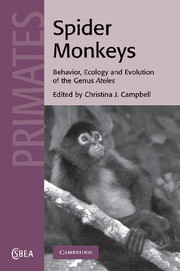Book contents
- Frontmatter
- Contents
- List of contributors
- Acknowledgements
- 1 Introduction
- Part I Taxonomy, phylogeny and evolution
- Part II Ecology
- Part III Behavior and reproduction
- 7 Locomotion and positional behavior of spider monkeys
- 8 Communication in spider monkeys: the function and mechanisms underlying the use of the whinny
- 9 Social interactions, social relationships and the social system of spider monkeys
- 10 Spider monkey reproduction and sexual behavior
- 11 Immaturity in spider monkeys: a risky business
- 12 Demography and group composition of Ateles
- Part IV Interactions with humans
- Index
- References
10 - Spider monkey reproduction and sexual behavior
Published online by Cambridge University Press: 05 May 2010
- Frontmatter
- Contents
- List of contributors
- Acknowledgements
- 1 Introduction
- Part I Taxonomy, phylogeny and evolution
- Part II Ecology
- Part III Behavior and reproduction
- 7 Locomotion and positional behavior of spider monkeys
- 8 Communication in spider monkeys: the function and mechanisms underlying the use of the whinny
- 9 Social interactions, social relationships and the social system of spider monkeys
- 10 Spider monkey reproduction and sexual behavior
- 11 Immaturity in spider monkeys: a risky business
- 12 Demography and group composition of Ateles
- Part IV Interactions with humans
- Index
- References
Summary
Introduction
Although studies on the behavioral ecology of spider monkeys are becoming more common (see Campbell, this volume), few data are currently available concerning their reproductive biology and sexual behavior. Early investigations provided information largely limited to life history parameters, indicating that spider monkeys show an extended gestation length (7–7.5 months; Eisenberg, 1973; Milton, 1981; Nunes and Chapman, 1997) and interbirth interval relative to most other monkeys (approximately three years, Eisenberg, 1973; Milton, 1981; Chapman and Chapman, 1990; C. J. Campbell, unpublished data). However, specific data pertaining to the reproductive biology and behavior of Ateles have continued to be underrepresented in the literature. The major hindrance limiting these types of investigations is the sheer difficulty of studying spider monkeys in the wild. In addition, spider monkey sexual behavior is rarely observed. Until the 1970s, copulation had never been reported, even in captivity (Klein, 1971) and thus was thought to occur at night (Eisenberg and Kuehn, 1966). Researchers carrying out long-term studies of Ateles in free-ranging conditions have consistently observed relatively low numbers of copulations (Table 10.1) reiterating this fact. One of the difficulties in observing copulations is related to the behavior of spider monkeys when they pair off to mate. Spider monkeys mate promiscuously, but copulations occur almost exclusively during a “consortship.” We define the term consortship as a specific social interaction when a male–female pair coordinate to stay apart from others in their social community for a few minutes, hours, or full days, and copulate (Symington, 1987; Campbell, 2000, 2006; K. N. Gibson, unpublished data).
- Type
- Chapter
- Information
- Spider MonkeysThe Biology, Behavior and Ecology of the Genus Ateles, pp. 266 - 287Publisher: Cambridge University PressPrint publication year: 2008
References
- 27
- Cited by

